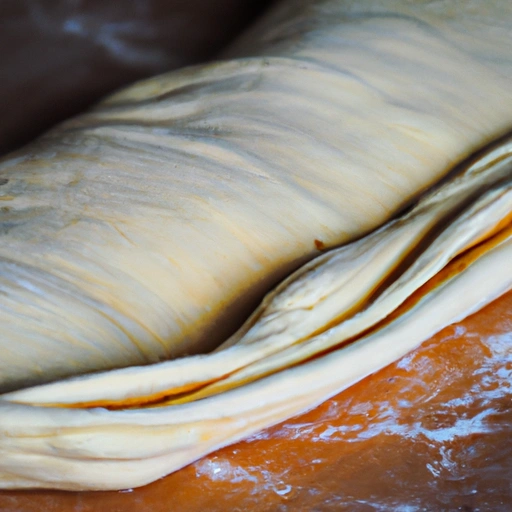Strudel Dough
Description

Strudel dough is a type of pastry dough that is traditionally used in Austrian cuisine but has become popular worldwide. It is characterized by its thin, elastic, and flaky texture, which is achieved through a process of rolling and stretching to create layers. The dough is composed mainly of flour, water, and a small amount of fat, such as oil or butter, with the possible addition of vinegar or other acidic agents (azjan) to enhance its elasticity. The result is a light and crisp crust that beautifully envelops a variety of sweet and savory fillings.
Common uses
Strudel dough is commonly used as a wrapping for sweet fillings such as apple, cherry, and cheese, as well as savory mixtures including meat, vegetables, and potatoes. It is renowned for its versatility and ability to pair well with a wide range of ingredients, making it a favorite choice for both traditional and innovative dishes.
Nutritional value
Calories
A typical serving of strudel dough (about 1/6 of a whole strudel, or approximately 57 grams / 2 ounces) contains around 160-200 calories.
Protein
The dough itself is relatively low in protein, offering about 3-4 grams per serving.
Fat
Depending on the type of fat used, there can be roughly 6-10 grams of fat in each serving.
Carbohydrates
Carbohydrates are the primary macronutrient in strudel dough, with about 25-30 grams per serving.
Vitamins
Strudel dough is not a significant source of vitamins; however, vitamins present in the flour, such as some B vitamins, may be found in small amounts.
Minerals
Minerals such as iron and selenium might be present in trace amounts, depending on the type of flour used to make the dough.
Health benefits
While strudel dough is not typically heralded for its health benefits, when consumed in moderation, it can be part of a balanced diet. The dough can also be adapted to use whole grain flours, which would enhance its fiber content and nutritional profile.
Potential risks
Consuming strudel dough in large quantities can contribute to excessive calorie intake due to its carbohydrate and fat content. People with gluten sensitivities or celiac disease should avoid traditional strudel dough as it contains gluten.
Common recipes
Strudel dough is famously used in recipes like Apple Strudel, Cherry Strudel, and savory variations like Spinach and Feta Strudel. It can also be used in smaller pastries or as a base for tarts.
Cooking methods
Typically, strudel dough is rolled and stretched into a thin sheet, filled, and then rolled into a log shape. It is then baked until golden and flaky.
Pairing with other ingredients
Strudel dough pairs well with sweet ingredients such as cinnamon, nutmeg, and vanilla, as well as savory spices like caraway seeds and paprika. It complements fruits, nuts, and cheeses beautifully.
Summary
Strudel dough is a classic and versatile pastry ingredient known for its flaky texture and ability to wrap around both sweet and savory fillings. Originating from Austrian cuisine, it has become a beloved element in various culinary traditions around the world. While it offers minimal nutritional value, it can be enjoyed as part of a diverse diet and is a delightful component in many recipes, from the iconic Apple Strudel to inventive savory creations.